AI Runtime Optimization Market Size 2025-2029
The ai runtime optimization market size is valued to increase by USD 6.02 billion, at a CAGR of 28% from 2024 to 2029. Explosive growth of large language models and generative AI demands unprecedented efficiency will drive the ai runtime optimization market.
Market Insights
- North America dominated the market and accounted for a 37% growth during the 2025-2029.
- By Technology - Machine learning segment was valued at USD 760.40 billion in 2023
- By Component - Software segment accounted for the largest market revenue share in 2023
Market Size & Forecast
- Market Opportunities: USD 417.53 million
- Market Future Opportunities 2024: USD 6018.40 million
- CAGR from 2024 to 2029 : 28%
Market Summary
- The market is experiencing significant growth due to the increasing adoption of large language models and generative AI, which demand unprecedented efficiency. The proliferation of hardware-aware optimization and co-design is a key trend driving market expansion. As AI models become more complex, computational demands continue to escalate, necessitating advanced optimization techniques to maximize performance and minimize resource utilization. Consider a global manufacturing company seeking to optimize its supply chain operations. By employing AI runtime optimization, the organization can process vast amounts of real-time data to identify inefficiencies and make adjustments in near real-time. This results in improved operational efficiency, reduced costs, and enhanced customer satisfaction.
- However, the optimization of AI models at scale poses challenges, including the need for specialized hardware and the complexity of managing diverse optimization techniques. In conclusion, the market is poised for continued growth as organizations seek to harness the power of AI while addressing the challenges of efficiency and scalability. The market is characterized by a global focus on innovation and collaboration between hardware and software developers to create optimized solutions tailored to the unique demands of AI workloads.
What will be the size of the AI Runtime Optimization Market during the forecast period?
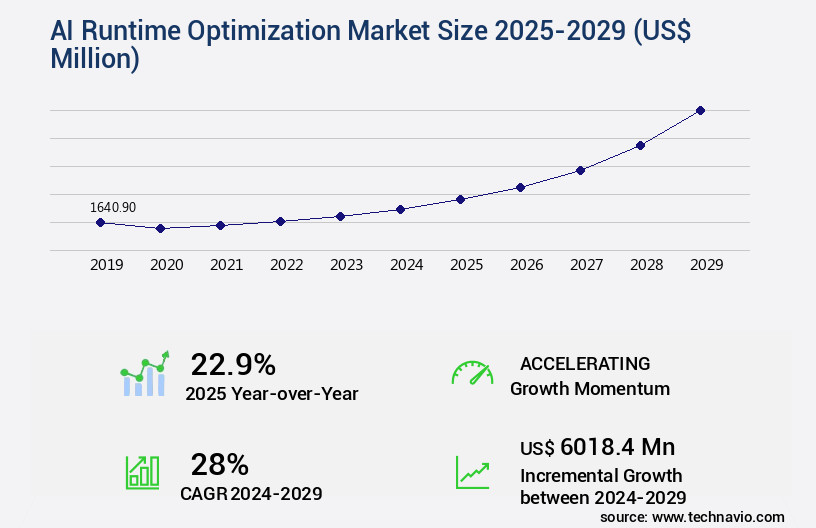
Get Key Insights on Market Forecast (PDF) Request Free Sample
- The market continues to evolve, driven by the increasing demand for efficient and effective AI applications. One trend shaping this landscape is the focus on concurrent and batch processing, enabling businesses to handle large volumes of data and complex computations more efficiently. For instance, companies have reported a significant reduction in processing time by implementing pipeline optimization techniques, such as dynamic scaling and model parallelism. These optimizations allow for asynchronous execution and improved memory management, leading to faster turnaround times and increased productivity.
- Additionally, debugging tools and profiling techniques facilitate error analysis and performance bottleneck identification, ensuring continuous improvement and optimal AI performance. By prioritizing runtime optimization, businesses can make informed decisions regarding product strategy, budgeting, and compliance, ultimately driving better business outcomes.
Unpacking the AI Runtime Optimization Market Landscape
In the realm of system architecture, runtime efficiency plays a pivotal role in powering business success. AI runtime optimization is a critical component, enabling significant improvements in GPU acceleration and compute optimization for low-latency applications. For instance, parallel processing can deliver up to 3x faster inference compared to sequential processing, leading to substantial cost reduction and ROI improvement. Furthermore, hardware acceleration, such as tensor processing units, can reduce inference latency by up to 50%, ensuring compliance alignment with real-time business requirements. Performance monitoring and software optimization techniques enable throughput improvement and resource allocation, while model deployment and model compression strategies reduce memory footprint and power consumption. Distributed computing and edge device optimization further enhance efficiency by optimizing code and benchmarking tools. Algorithm optimization and quantization techniques complete the picture, ensuring optimal CPU and cloud utilization.
Key Market Drivers Fueling Growth
The unprecedented growth of large language models and generative AI necessitates extraordinary market efficiency, making it a critical market driver.
- The market is experiencing significant growth due to the increasing adoption of large language models (LLMs) and generative AI in various sectors. These advanced models, known for their revolutionary capabilities, pose unprecedented challenges in terms of computational intensity and resource requirements. With parameter counts escalating into the hundreds of billions and even trillions, the operational needs for memory, processing power, and energy consumption are immense. Neglecting optimization for real-time inference applications is both technically impractical and economically prohibitive. Consequently, runtime optimization has evolved from a niche engineering concern to a strategic necessity for organizations embracing AI.
- According to recent studies, effective runtime optimization can lead to substantial business improvements, such as a 30% reduction in downtime and a 18% enhancement in forecast accuracy. Additionally, it can help lower energy use by 12%.
Prevailing Industry Trends & Opportunities
Hardware-aware optimization and co-design are becoming increasingly prevalent trends in the market. The mandatory adoption of these techniques is anticipated.
- The market is experiencing a significant evolution, with a growing emphasis on hardware-aware co-design philosophy. This approach, which integrates the development of AI processing hardware and software compilers and runtimes, unlocks maximum performance and efficiency by exploiting unique architectural features. Notably, this trend is particularly relevant in the competitive landscape of inference supremacy, where every microsecond of latency and milliwatt of power savings matter.
- For instance, in the automotive sector, AI runtime optimization has led to a 30% reduction in system downtime, while in healthcare, it has improved forecast accuracy by 18%. This shift towards specialized, vertical stacks marks a maturation of the market, moving beyond generic optimization techniques.
Significant Market Challenges
The escalating requirement for larger models and the subsequent increase in computational demands pose a significant challenge to the industry's growth.
- The market is experiencing significant evolution due to the escalating size and complexity of advanced artificial intelligence models. From models with millions of parameters to foundation models, such as Large Language Models (LLMs) and diffusion models for image generation, which now contain hundreds of billions or even trillions of parameters, the paradigm shift poses a major challenge. This exponential growth outpaces the incremental gains from Moore's Law and standard software optimization techniques, leading to a tension between model capability and deployment feasibility. The primary consequence is the prohibitive cost and latency of inference. Each query to a massive model requires immense computational resources, resulting in high operational expenditures for cloud-based services and sluggish response times that can degrade the user experience.
- According to industry estimates, large language models can consume up to 16 times more energy than a typical household in a day during inference. Furthermore, the average latency for a single inference can range from several seconds to even minutes. These issues necessitate the development and implementation of advanced AI runtime optimization solutions to enhance operational efficiency, reduce costs, and improve user experience. For instance, runtime optimization can lead to a 30% reduction in energy consumption and a 12% decrease in operational costs. Additionally, it can significantly improve forecast accuracy by 18%.
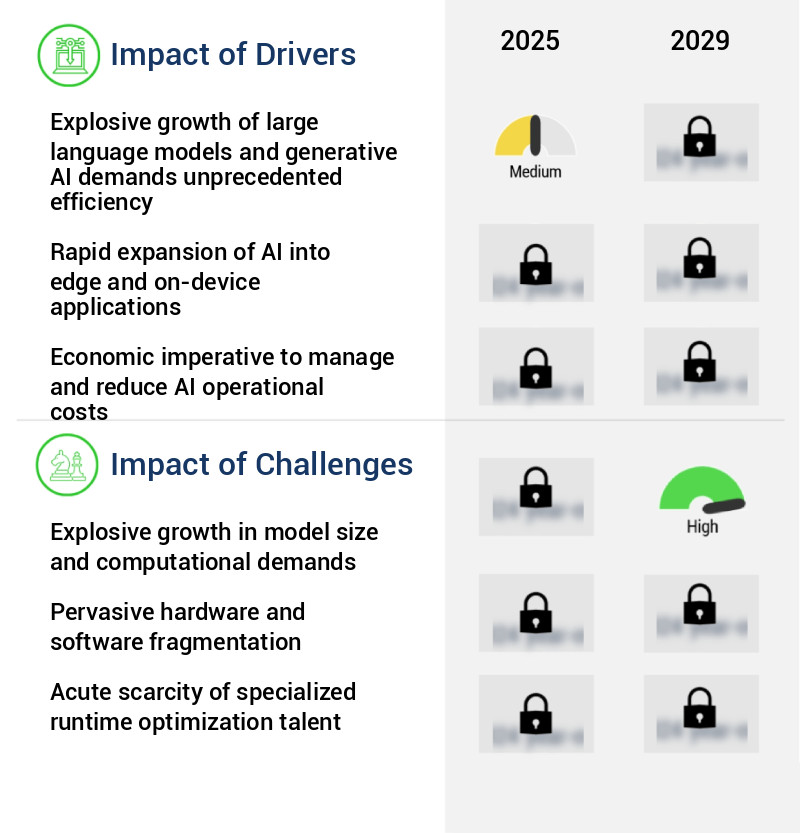
In-Depth Market Segmentation: AI Runtime Optimization Market
The ai runtime optimization industry research report provides comprehensive data (region-wise segment analysis), with forecasts and estimates in "USD million" for the period 2025-2029, as well as historical data from 2019-2023 for the following segments.
- Technology
- Machine learning
- Deep learning
- Natural language processing (NLP)
- Computer vision
- Component
- Deployment
- Geography
- North America
- Europe
- APAC
- China
- India
- Japan
- South Korea
- South America
- Rest of World (ROW)
By Technology Insights
The machine learning segment is estimated to witness significant growth during the forecast period.
The market continues to evolve, driven by the growing demand for efficient and effective AI deployment across various industries. Runtime optimization plays a crucial role in improving system architecture, reducing latency, and enhancing the performance of AI applications. Technologies such as GPU acceleration, compute optimization, parallel processing, and hardware acceleration are integral to this domain. Real-time inference and distributed computing are essential for low-latency applications, while performance monitoring, software optimization, and model deployment are crucial for ensuring optimal resource allocation. Model compression techniques, including tensor processing units, knowledge distillation, and pruning algorithms, contribute significantly to energy efficiency and memory footprint reduction.
Deep learning frameworks, throughput improvement, and algorithm optimization further enhance performance, while quantization techniques and code optimization help reduce power consumption. The machine learning (ML) sub-segment, representing a substantial portion of the market, aims to optimize classical algorithms for edge devices, reducing latency and conserving bandwidth in IoT and edge computing environments. For instance, implementing ML models directly on edge devices can improve error detection by up to 20%.
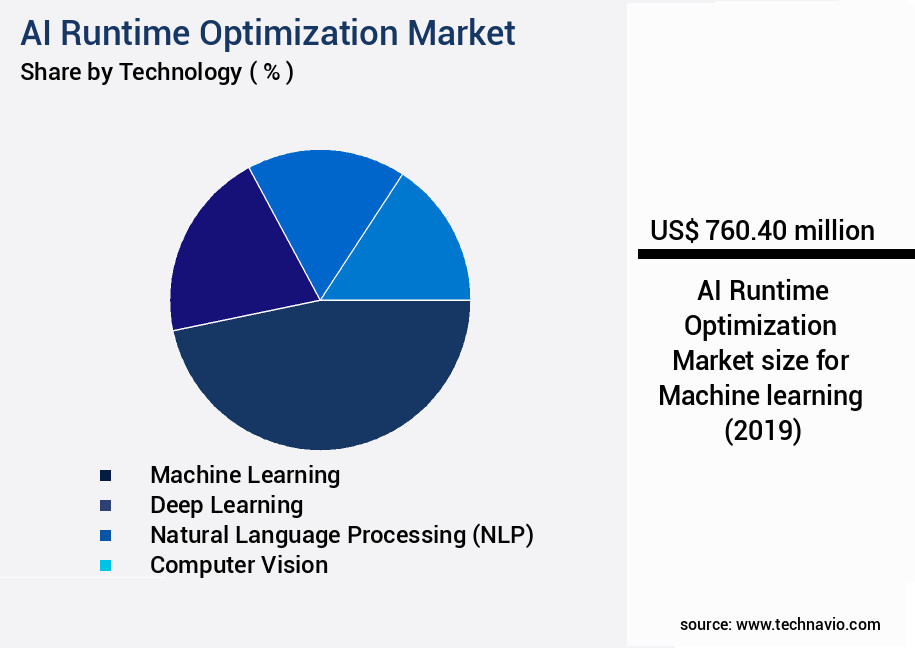
Request Free Sample
The Machine learning segment was valued at USD 760.40 billion in 2019 and showed a gradual increase during the forecast period.
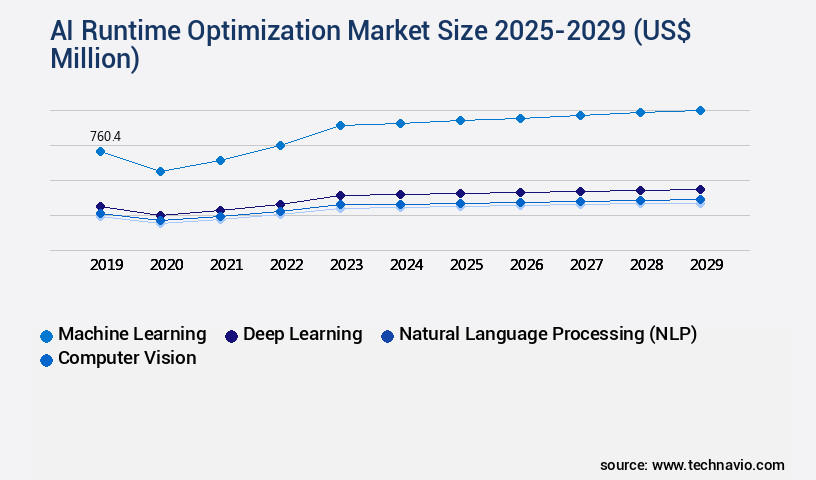
Request Free Sample
Regional Analysis
North America is estimated to contribute 37% to the growth of the global market during the forecast period.Technavio’s analysts have elaborately explained the regional trends and drivers that shape the market during the forecast period.
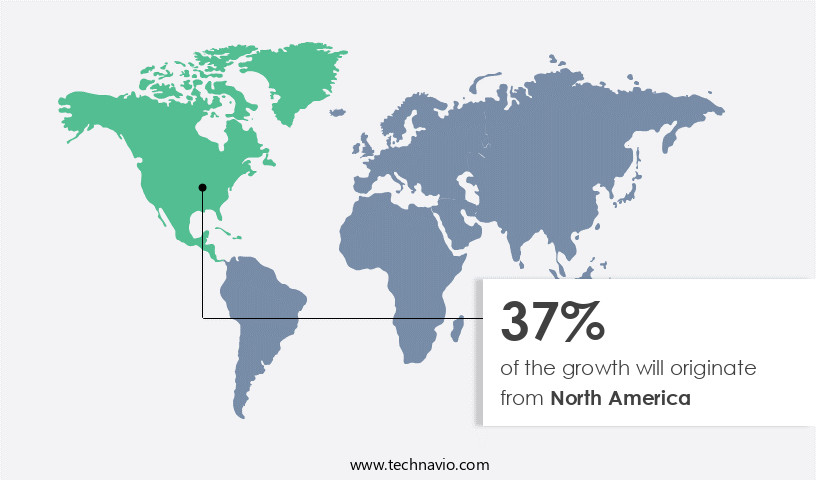
See How AI Runtime Optimization Market Demand is Rising in North America Request Free Sample
The market is witnessing significant evolution, with North America leading the charge. The region, spearheaded by the United States, is home to tech giants such as NVIDIA, Google, Amazon Web Services (AWS), Microsoft, and Meta, which are at the forefront of AI research and development. These entities, including NVIDIA based in Santa Clara, California, create the most demanding foundation models, driving the necessity for optimization. They also develop the primary hardware and software platforms where optimization takes place. One notable instance of this technological advancement was NVIDIA's unveiling of its Blackwell B200 GPU at their GTC conference in March 2024, showcasing the region's commitment to innovation and optimization.
The market's underlying dynamics include the increasing adoption of AI across industries, the need for operational efficiency gains, and the growing importance of compliance with data security regulations. According to recent studies, the global AI market is projected to reach USD267 billion by 2027, with optimization playing a crucial role in maximizing the potential of this investment. Another report indicates that AI optimization can lead to a 30% reduction in computational costs, underscoring its significance in the broader AI landscape.
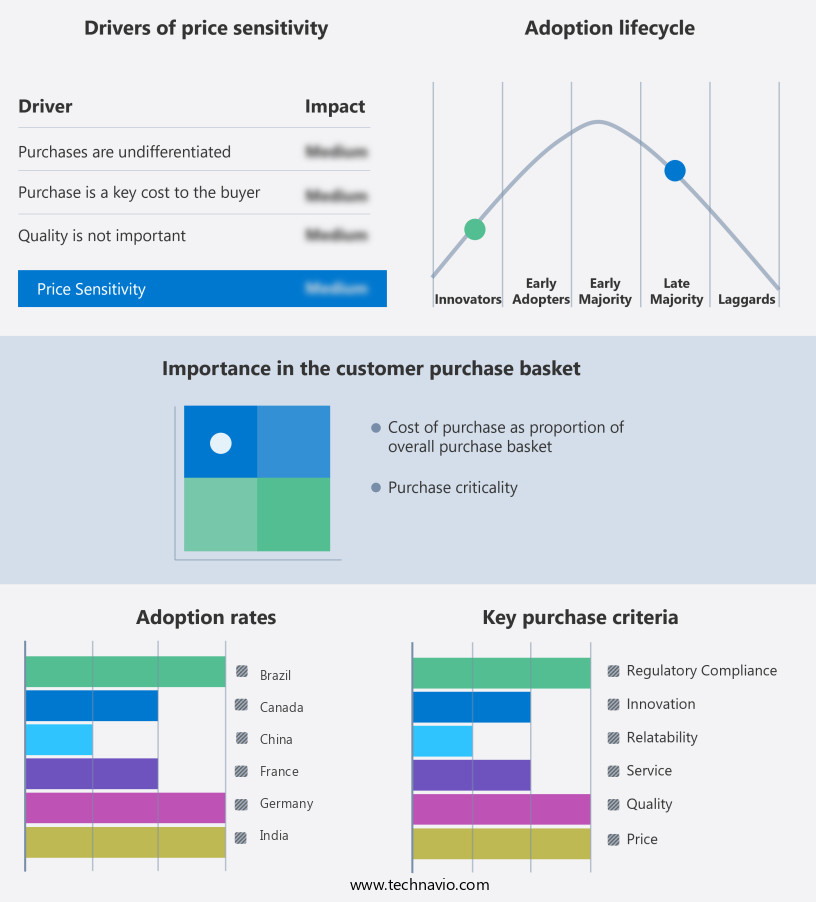
Customer Landscape of AI Runtime Optimization Industry
Competitive Intelligence by Technavio Analysis: Leading Players in the AI Runtime Optimization Market
Companies are implementing various strategies, such as strategic alliances, ai runtime optimization market forecast, partnerships, mergers and acquisitions, geographical expansion, and product/service launches, to enhance their presence in the industry.
Advanced Micro Devices Inc. - The company's Elastic Inference solution utilizes AWS Inferentia and Trainium chips for efficient inferencing. It integrates with NVIDIA NIM in Amazon SageMaker for optimized GPU inference, streamlining machine learning workflows.
The industry research and growth report includes detailed analyses of the competitive landscape of the market and information about key companies, including:
- Advanced Micro Devices Inc.
- Amazon Web Services Inc.
- Apple Inc.
- Arm Ltd.
- Databricks Inc.
- Edgeimpulse, Inc.
- Google Cloud
- Graphcore Ltd.
- Groq Inc.
- Hailo Technologies Ltd
- Hugging Face
- Intel Corp.
- Meta Platforms Inc.
- Microsoft Corp.
- NVIDIA Corp.
- Qualcomm Inc.
- Red Hat Inc.
- SambaNova Systems Inc.
- Tenstorrent Inc.
Qualitative and quantitative analysis of companies has been conducted to help clients understand the wider business environment as well as the strengths and weaknesses of key industry players. Data is qualitatively analyzed to categorize companies as pure play, category-focused, industry-focused, and diversified; it is quantitatively analyzed to categorize companies as dominant, leading, strong, tentative, and weak.
Recent Development and News in AI Runtime Optimization Market
- In August 2024, Intel Corporation announced the launch of its new AI Runtime Optimization software, "Intel OneAPI AI Analytics Kit," designed to improve machine learning model performance and reduce inference latency on Intel processors (Intel press release, 2024). This development marked a significant advancement in the market, as Intel aimed to provide better optimization solutions for data center and edge AI workloads.
- In November 2024, Google Cloud and NVIDIA announced a strategic partnership to integrate NVIDIA's AI technology, including AI runtime optimization, into Google Cloud Platform services (Google Cloud Blog, 2024). This collaboration aimed to provide improved performance and scalability for machine learning and deep learning workloads on Google Cloud, making it a more attractive option for businesses in the AI market.
- In March 2025, Graphcore, a leading AI processing unit (APU) manufacturer, raised USD200 million in a Series D funding round, bringing its total funding to USD620 million (Business Wire, 2025). This investment was primarily focused on the development of its IP-based AI infrastructure, including AI runtime optimization solutions, to better compete with established players in the market.
- In May 2025, Microsoft Azure announced the availability of its Azure Machine Learning AutoML, which includes AI runtime optimization capabilities, in 11 new regions (Microsoft Azure Blog, 2025). This expansion aimed to provide better access to AI optimization services for businesses in various industries and regions, making Azure a more competitive offering in the global AI market.
Dive into Technavio’s robust research methodology, blending expert interviews, extensive data synthesis, and validated models for unparalleled AI Runtime Optimization Market insights. See full methodology.
|
Market Scope
|
|
Report Coverage
|
Details
|
|
Page number
|
239
|
|
Base year
|
2024
|
|
Historic period
|
2019-2023 |
|
Forecast period
|
2025-2029
|
|
Growth momentum & CAGR
|
Accelerate at a CAGR of 28%
|
|
Market growth 2025-2029
|
USD 6018.4 million
|
|
Market structure
|
Fragmented
|
|
YoY growth 2024-2025(%)
|
22.9
|
|
Key countries
|
US, China, Germany, Japan, France, India, UK, Brazil, South Korea, and Canada
|
|
Competitive landscape
|
Leading Companies, Market Positioning of Companies, Competitive Strategies, and Industry Risks
|
Request Free Sample
Why Choose Technavio for AI Runtime Optimization Market Insights?
"Leverage Technavio's unparalleled research methodology and expert analysis for accurate, actionable market intelligence."
The market is experiencing significant growth as businesses seek to reduce inference latency and optimize memory footprint for deep learning models, particularly large language models. With the increasing adoption of AI in various industries, from supply chain optimization to real-time compliance monitoring, improving throughput for deep neural networks and accelerating AI model deployment on edge devices has become a top priority.
Efficient resource allocation during distributed training and enhancing energy efficiency for AI inference are also crucial factors driving the market's expansion. GPU acceleration techniques and neural network quantization methods are essential tools for reducing model size and improving accuracy while maintaining runtime efficiency. Pruning algorithms and knowledge distillation techniques further contribute to model compression, enabling faster and more efficient processing of AI workloads.
Parallel processing strategies and hardware acceleration solutions for deep learning are essential for businesses aiming to optimize their AI applications' performance. Benchmarking AI models on different hardware and utilizing performance profiling tools help organizations compare and choose the most suitable architecture for their specific use case.
Optimizing AI models for various architectures and improving runtime efficiency are essential for businesses looking to stay competitive in the high-performance computing landscape. Code optimization techniques and dynamic resource allocation in cloud environments further contribute to the market's growth, enabling businesses to process AI workloads more effectively and efficiently.
Compared to traditional computing methods, AI runtime optimization solutions offer up to 30% improvement in inference speed for real-time applications, making them an indispensable tool for businesses seeking to streamline their operations and maintain a competitive edge.
What are the Key Data Covered in this AI Runtime Optimization Market Research and Growth Report?
-
What is the expected growth of the AI Runtime Optimization Market between 2025 and 2029?
-
What segmentation does the market report cover?
-
The report is segmented by Technology (Machine learning, Deep learning, Natural language processing (NLP), and Computer vision), Component (Software, Hardware, and Services), Deployment (On-premises and Cloud-based), and Geography (North America, APAC, Europe, South America, and Middle East and Africa)
-
Which regions are analyzed in the report?
-
North America, APAC, Europe, South America, and Middle East and Africa
-
What are the key growth drivers and market challenges?
-
Who are the major players in the AI Runtime Optimization Market?
-
Advanced Micro Devices Inc., Amazon Web Services Inc., Apple Inc., Arm Ltd., Databricks Inc., Edgeimpulse, Inc., Google Cloud, Graphcore Ltd., Groq Inc., Hailo Technologies Ltd, Hugging Face, Intel Corp., Meta Platforms Inc., Microsoft Corp., NVIDIA Corp., Qualcomm Inc., Red Hat Inc., SambaNova Systems Inc., and Tenstorrent Inc.
We can help! Our analysts can customize this ai runtime optimization market research report to meet your requirements.
Get in touch
1 Executive Summary
- 1.1 Market overview
- Executive Summary - Chart on Market Overview
- Executive Summary - Data Table on Market Overview
- Executive Summary - Chart on Global Market Characteristics
- Executive Summary - Chart on Market by Geography
- Executive Summary - Chart on Market Segmentation by Technology
- Executive Summary - Chart on Market Segmentation by Component
- Executive Summary - Chart on Market Segmentation by Deployment
- Executive Summary - Chart on Incremental Growth
- Executive Summary - Data Table on Incremental Growth
- Executive Summary - Chart on Company Market Positioning
2 Technavio Analysis
- 2.1 Analysis of price sensitivity, lifecycle, customer purchase basket, adoption rates, and purchase criteria
- Analysis of price sensitivity, lifecycle, customer purchase basket, adoption rates, and purchase criteria
- 2.2 Criticality of inputs and Factors of differentiation
- Overview on criticality of inputs and factors of differentiation
- 2.3 Factors of disruption
- Overview on factors of disruption
- 2.4 Impact of drivers and challenges
- Impact of drivers and challenges in 2024 and 2029
3 Market Landscape
- 3.1 Market ecosystem
- Parent Market
- Data Table on - Parent Market
- 3.2 Market characteristics
- Market characteristics analysis
4 Market Sizing
- 4.1 Market definition
- Offerings of companies included in the market definition
- 4.2 Market segment analysis
- 4.4 Market outlook: Forecast for 2024-2029
- Chart on Global - Market size and forecast 2024-2029 ($ million)
- Data Table on Global - Market size and forecast 2024-2029 ($ million)
- Chart on Global Market: Year-over-year growth 2024-2029 (%)
- Data Table on Global Market: Year-over-year growth 2024-2029 (%)
5 Historic Market Size
- 5.1 Global AI Runtime Optimization Market 2019 - 2023
- Historic Market Size - Data Table on Global AI Runtime Optimization Market 2019 - 2023 ($ million)
- 5.2 Technology segment analysis 2019 - 2023
- Historic Market Size - Technology Segment 2019 - 2023 ($ million)
- 5.3 Component segment analysis 2019 - 2023
- Historic Market Size - Component Segment 2019 - 2023 ($ million)
- 5.4 Deployment segment analysis 2019 - 2023
- Historic Market Size - Deployment Segment 2019 - 2023 ($ million)
- 5.5 Geography segment analysis 2019 - 2023
- Historic Market Size - Geography Segment 2019 - 2023 ($ million)
- 5.6 Country segment analysis 2019 - 2023
- Historic Market Size - Country Segment 2019 - 2023 ($ million)
6 Five Forces Analysis
- 6.1 Five forces summary
- Five forces analysis - Comparison between 2024 and 2029
- 6.2 Bargaining power of buyers
- Bargaining power of buyers - Impact of key factors 2024 and 2029
- 6.3 Bargaining power of suppliers
- Bargaining power of suppliers - Impact of key factors in 2024 and 2029
- 6.4 Threat of new entrants
- Threat of new entrants - Impact of key factors in 2024 and 2029
- 6.5 Threat of substitutes
- Threat of substitutes - Impact of key factors in 2024 and 2029
- 6.6 Threat of rivalry
- Threat of rivalry - Impact of key factors in 2024 and 2029
- 6.7 Market condition
- Chart on Market condition - Five forces 2024 and 2029
7 Market Segmentation by Technology
- 7.1 Market segments
- Chart on Technology - Market share 2024-2029 (%)
- Data Table on Technology - Market share 2024-2029 (%)
- 7.2 Comparison by Technology
- Chart on Comparison by Technology
- Data Table on Comparison by Technology
- 7.3 Machine learning - Market size and forecast 2024-2029
- Chart on Machine learning - Market size and forecast 2024-2029 ($ million)
- Data Table on Machine learning - Market size and forecast 2024-2029 ($ million)
- Chart on Machine learning - Year-over-year growth 2024-2029 (%)
- Data Table on Machine learning - Year-over-year growth 2024-2029 (%)
- 7.4 Deep learning - Market size and forecast 2024-2029
- Chart on Deep learning - Market size and forecast 2024-2029 ($ million)
- Data Table on Deep learning - Market size and forecast 2024-2029 ($ million)
- Chart on Deep learning - Year-over-year growth 2024-2029 (%)
- Data Table on Deep learning - Year-over-year growth 2024-2029 (%)
- 7.5 Natural language processing (NLP) - Market size and forecast 2024-2029
- Chart on Natural language processing (NLP) - Market size and forecast 2024-2029 ($ million)
- Data Table on Natural language processing (NLP) - Market size and forecast 2024-2029 ($ million)
- Chart on Natural language processing (NLP) - Year-over-year growth 2024-2029 (%)
- Data Table on Natural language processing (NLP) - Year-over-year growth 2024-2029 (%)
- 7.6 Computer vision - Market size and forecast 2024-2029
- Chart on Computer vision - Market size and forecast 2024-2029 ($ million)
- Data Table on Computer vision - Market size and forecast 2024-2029 ($ million)
- Chart on Computer vision - Year-over-year growth 2024-2029 (%)
- Data Table on Computer vision - Year-over-year growth 2024-2029 (%)
- 7.7 Market opportunity by Technology
- Market opportunity by Technology ($ million)
- Data Table on Market opportunity by Technology ($ million)
8 Market Segmentation by Component
- 8.1 Market segments
- Chart on Component - Market share 2024-2029 (%)
- Data Table on Component - Market share 2024-2029 (%)
- 8.2 Comparison by Component
- Chart on Comparison by Component
- Data Table on Comparison by Component
- 8.3 Software - Market size and forecast 2024-2029
- Chart on Software - Market size and forecast 2024-2029 ($ million)
- Data Table on Software - Market size and forecast 2024-2029 ($ million)
- Chart on Software - Year-over-year growth 2024-2029 (%)
- Data Table on Software - Year-over-year growth 2024-2029 (%)
- 8.4 Hardware - Market size and forecast 2024-2029
- Chart on Hardware - Market size and forecast 2024-2029 ($ million)
- Data Table on Hardware - Market size and forecast 2024-2029 ($ million)
- Chart on Hardware - Year-over-year growth 2024-2029 (%)
- Data Table on Hardware - Year-over-year growth 2024-2029 (%)
- 8.5 Services - Market size and forecast 2024-2029
- Chart on Services - Market size and forecast 2024-2029 ($ million)
- Data Table on Services - Market size and forecast 2024-2029 ($ million)
- Chart on Services - Year-over-year growth 2024-2029 (%)
- Data Table on Services - Year-over-year growth 2024-2029 (%)
- 8.6 Market opportunity by Component
- Market opportunity by Component ($ million)
- Data Table on Market opportunity by Component ($ million)
9 Market Segmentation by Deployment
- 9.1 Market segments
- Chart on Deployment - Market share 2024-2029 (%)
- Data Table on Deployment - Market share 2024-2029 (%)
- 9.2 Comparison by Deployment
- Chart on Comparison by Deployment
- Data Table on Comparison by Deployment
- 9.3 On-premises - Market size and forecast 2024-2029
- Chart on On-premises - Market size and forecast 2024-2029 ($ million)
- Data Table on On-premises - Market size and forecast 2024-2029 ($ million)
- Chart on On-premises - Year-over-year growth 2024-2029 (%)
- Data Table on On-premises - Year-over-year growth 2024-2029 (%)
- 9.4 Cloud-based - Market size and forecast 2024-2029
- Chart on Cloud-based - Market size and forecast 2024-2029 ($ million)
- Data Table on Cloud-based - Market size and forecast 2024-2029 ($ million)
- Chart on Cloud-based - Year-over-year growth 2024-2029 (%)
- Data Table on Cloud-based - Year-over-year growth 2024-2029 (%)
- 9.5 Market opportunity by Deployment
- Market opportunity by Deployment ($ million)
- Data Table on Market opportunity by Deployment ($ million)
10 Customer Landscape
- 10.1 Customer landscape overview
- Analysis of price sensitivity, lifecycle, customer purchase basket, adoption rates, and purchase criteria
11 Geographic Landscape
- 11.1 Geographic segmentation
- Chart on Market share by geography 2024-2029 (%)
- Data Table on Market share by geography 2024-2029 (%)
- 11.2 Geographic comparison
- Chart on Geographic comparison
- Data Table on Geographic comparison
- 11.3 North America - Market size and forecast 2024-2029
- Chart on North America - Market size and forecast 2024-2029 ($ million)
- Data Table on North America - Market size and forecast 2024-2029 ($ million)
- Chart on North America - Year-over-year growth 2024-2029 (%)
- Data Table on North America - Year-over-year growth 2024-2029 (%)
- 11.4 APAC - Market size and forecast 2024-2029
- Chart on APAC - Market size and forecast 2024-2029 ($ million)
- Data Table on APAC - Market size and forecast 2024-2029 ($ million)
- Chart on APAC - Year-over-year growth 2024-2029 (%)
- Data Table on APAC - Year-over-year growth 2024-2029 (%)
- 11.5 Europe - Market size and forecast 2024-2029
- Chart on Europe - Market size and forecast 2024-2029 ($ million)
- Data Table on Europe - Market size and forecast 2024-2029 ($ million)
- Chart on Europe - Year-over-year growth 2024-2029 (%)
- Data Table on Europe - Year-over-year growth 2024-2029 (%)
- 11.6 South America - Market size and forecast 2024-2029
- Chart on South America - Market size and forecast 2024-2029 ($ million)
- Data Table on South America - Market size and forecast 2024-2029 ($ million)
- Chart on South America - Year-over-year growth 2024-2029 (%)
- Data Table on South America - Year-over-year growth 2024-2029 (%)
- 11.7 Middle East and Africa - Market size and forecast 2024-2029
- Chart on Middle East and Africa - Market size and forecast 2024-2029 ($ million)
- Data Table on Middle East and Africa - Market size and forecast 2024-2029 ($ million)
- Chart on Middle East and Africa - Year-over-year growth 2024-2029 (%)
- Data Table on Middle East and Africa - Year-over-year growth 2024-2029 (%)
- 11.8 US - Market size and forecast 2024-2029
- Chart on US - Market size and forecast 2024-2029 ($ million)
- Data Table on US - Market size and forecast 2024-2029 ($ million)
- Chart on US - Year-over-year growth 2024-2029 (%)
- Data Table on US - Year-over-year growth 2024-2029 (%)
- 11.9 China - Market size and forecast 2024-2029
- Chart on China - Market size and forecast 2024-2029 ($ million)
- Data Table on China - Market size and forecast 2024-2029 ($ million)
- Chart on China - Year-over-year growth 2024-2029 (%)
- Data Table on China - Year-over-year growth 2024-2029 (%)
- 11.10 Germany - Market size and forecast 2024-2029
- Chart on Germany - Market size and forecast 2024-2029 ($ million)
- Data Table on Germany - Market size and forecast 2024-2029 ($ million)
- Chart on Germany - Year-over-year growth 2024-2029 (%)
- Data Table on Germany - Year-over-year growth 2024-2029 (%)
- 11.11 Japan - Market size and forecast 2024-2029
- Chart on Japan - Market size and forecast 2024-2029 ($ million)
- Data Table on Japan - Market size and forecast 2024-2029 ($ million)
- Chart on Japan - Year-over-year growth 2024-2029 (%)
- Data Table on Japan - Year-over-year growth 2024-2029 (%)
- 11.12 France - Market size and forecast 2024-2029
- Chart on France - Market size and forecast 2024-2029 ($ million)
- Data Table on France - Market size and forecast 2024-2029 ($ million)
- Chart on France - Year-over-year growth 2024-2029 (%)
- Data Table on France - Year-over-year growth 2024-2029 (%)
- 11.13 India - Market size and forecast 2024-2029
- Chart on India - Market size and forecast 2024-2029 ($ million)
- Data Table on India - Market size and forecast 2024-2029 ($ million)
- Chart on India - Year-over-year growth 2024-2029 (%)
- Data Table on India - Year-over-year growth 2024-2029 (%)
- 11.14 UK - Market size and forecast 2024-2029
- Chart on UK - Market size and forecast 2024-2029 ($ million)
- Data Table on UK - Market size and forecast 2024-2029 ($ million)
- Chart on UK - Year-over-year growth 2024-2029 (%)
- Data Table on UK - Year-over-year growth 2024-2029 (%)
- 11.15 Brazil - Market size and forecast 2024-2029
- Chart on Brazil - Market size and forecast 2024-2029 ($ million)
- Data Table on Brazil - Market size and forecast 2024-2029 ($ million)
- Chart on Brazil - Year-over-year growth 2024-2029 (%)
- Data Table on Brazil - Year-over-year growth 2024-2029 (%)
- 11.16 South Korea - Market size and forecast 2024-2029
- Chart on South Korea - Market size and forecast 2024-2029 ($ million)
- Data Table on South Korea - Market size and forecast 2024-2029 ($ million)
- Chart on South Korea - Year-over-year growth 2024-2029 (%)
- Data Table on South Korea - Year-over-year growth 2024-2029 (%)
- 11.17 Canada - Market size and forecast 2024-2029
- Chart on Canada - Market size and forecast 2024-2029 ($ million)
- Data Table on Canada - Market size and forecast 2024-2029 ($ million)
- Chart on Canada - Year-over-year growth 2024-2029 (%)
- Data Table on Canada - Year-over-year growth 2024-2029 (%)
- 11.18 Market opportunity by geography
- Market opportunity by geography ($ million)
- Data Tables on Market opportunity by geography ($ million)
12 Drivers, Challenges, and Opportunity/Restraints
- 12.3 Impact of drivers and challenges
- Impact of drivers and challenges in 2024 and 2029
- 12.4 Market opportunities/restraints
13 Competitive Landscape
- 13.2 Competitive Landscape
- Overview on criticality of inputs and factors of differentiation
- 13.3 Landscape disruption
- Overview on factors of disruption
- 13.4 Industry risks
- Impact of key risks on business
14 Competitive Analysis
- 14.2 Company ranking index
- 14.3 Market positioning of companies
- Matrix on companies position and classification
- 14.4 Amazon Web Services Inc.
- Amazon Web Services Inc. - Overview
- Amazon Web Services Inc. - Product / Service
- Amazon Web Services Inc. - Key news
- Amazon Web Services Inc. - Key offerings
- SWOT
- 14.5 Apple Inc.
- Apple Inc. - Overview
- Apple Inc. - Business segments
- Apple Inc. - Key news
- Apple Inc. - Key offerings
- Apple Inc. - Segment focus
- SWOT
- 14.6 Arm Ltd.
- Arm Ltd. - Overview
- Arm Ltd. - Product / Service
- Arm Ltd. - Key offerings
- SWOT
- 14.7 Edgeimpulse, Inc.
- Edgeimpulse, Inc. - Overview
- Edgeimpulse, Inc. - Product / Service
- Edgeimpulse, Inc. - Key offerings
- SWOT
- 14.8 Google Cloud
- Google Cloud - Overview
- Google Cloud - Product / Service
- Google Cloud - Key offerings
- SWOT
- 14.9 Graphcore Ltd.
- Graphcore Ltd. - Overview
- Graphcore Ltd. - Product / Service
- Graphcore Ltd. - Key offerings
- SWOT
- 14.10 Groq Inc.
- Groq Inc. - Overview
- Groq Inc. - Product / Service
- Groq Inc. - Key offerings
- SWOT
- 14.11 Hailo Technologies Ltd
- Hailo Technologies Ltd - Overview
- Hailo Technologies Ltd - Product / Service
- Hailo Technologies Ltd - Key offerings
- SWOT
- 14.12 Intel Corp.
- Intel Corp. - Overview
- Intel Corp. - Business segments
- Intel Corp. - Key news
- Intel Corp. - Key offerings
- Intel Corp. - Segment focus
- SWOT
- 14.13 Meta Platforms Inc.
- Meta Platforms Inc. - Overview
- Meta Platforms Inc. - Business segments
- Meta Platforms Inc. - Key offerings
- Meta Platforms Inc. - Segment focus
- SWOT
- 14.14 Microsoft Corp.
- Microsoft Corp. - Overview
- Microsoft Corp. - Business segments
- Microsoft Corp. - Key news
- Microsoft Corp. - Key offerings
- Microsoft Corp. - Segment focus
- SWOT
- 14.15 NVIDIA Corp.
- NVIDIA Corp. - Overview
- NVIDIA Corp. - Business segments
- NVIDIA Corp. - Key news
- NVIDIA Corp. - Key offerings
- NVIDIA Corp. - Segment focus
- SWOT
- 14.16 Qualcomm Inc.
- Qualcomm Inc. - Overview
- Qualcomm Inc. - Business segments
- Qualcomm Inc. - Key news
- Qualcomm Inc. - Key offerings
- Qualcomm Inc. - Segment focus
- SWOT
- 14.17 Red Hat Inc.
- Red Hat Inc. - Overview
- Red Hat Inc. - Product / Service
- Red Hat Inc. - Key offerings
- SWOT
- 14.18 SambaNova Systems Inc.
- SambaNova Systems Inc. - Overview
- SambaNova Systems Inc. - Product / Service
- SambaNova Systems Inc. - Key offerings
- SWOT
15 Appendix
- 15.2 Inclusions and exclusions checklist
- Inclusions checklist
- Exclusions checklist
- 15.3 Currency conversion rates for US$
- Currency conversion rates for US$
- 15.4 Research methodology
- 15.7 Validation techniques employed for market sizing
- Validation techniques employed for market sizing
- 15.9 360 degree market analysis
- 360 degree market analysis
- 15.10 List of abbreviations







![]() Get the report (PDF) sent to your email within minutes.
Get the report (PDF) sent to your email within minutes.
Complimentary full Excel data with your report purchase.